Osteoarthritis is a pathology in which there is gradual deformity of the joints. In the early stages, cartilage and ligaments are destroyed. This process is slow, so the disease is detected at a late stage of development. In the future, this can lead to loss of mobility and disability.
The risk of developing osteoarthritis increases with age. The disease affects both men and women equally.
Symptom
Joint pain when moving is the main symptom of the disease, so many people go to the doctor and get treatment promptly. Discomfort manifests itself with prolonged walking or vigorous exertion.
Your doctor will tell you during the diagnosis. The following symptoms may be suspected:
- nocturnal pain due to stagnation of venous blood and increased pressure inside the joint;
- the appearance of a crackling sound due to the friction of the collapsed cartilage;
- Pain increases with heavy lifting, this is especially evident in knee osteoarthritis when squatting, playing sports (running, jumping, lifting weights), carrying weights;
- depending on the weather, when the affected joints begin to hurt when the weather changes, especially before heavy rain or snow, freezing cold;
- morning stiffness.
Difference between osteoarthritis and osteoarthritis, doctor's answer
A well-known doctor and health TV presenter says that the terms "arthritis" and "osteoarthritis" mean a disease in which cartilage is damaged and bone tissue grows.
With osteoarthritis, the cartilage tissue of the joint surface is destroyed, the mobility of the limbs is limited, and severe pain occurs. The pathology is diagnosed in men and women over 40 years old (the main cause in women is the onset of menopause, when there are hormonal changes in the body).
Osteoarthritis is a manifestation of the deformation of articular cartilage and affects bone tissue, affecting the entire joint, leading to disability.
Other diseases with similar symptoms
There are several diseases that have similar symptoms to arthritis:
- Periarticular osteoarthritis, cervical osteochondrosis, osteoporosis and shoulder arthritis.
- Osteoarthritis of the elbow, degenerative joint deformity, rheumatoid arthritis of the hand.
- Coxarthrosis disease.
- Rheumatoid arthritis and septic arthritis in children.
Types of localized joint diseases
The types of disease vary depending on the location of the affected joint. The mildest type of pathology is the shoulder. Osteoarthritis can be diagnosed:
- cervical region;
- knee joint (affects both legs, but develops to varying degrees);
- fish's eyes;
- hip joint (a pathology characteristic of the elderly).
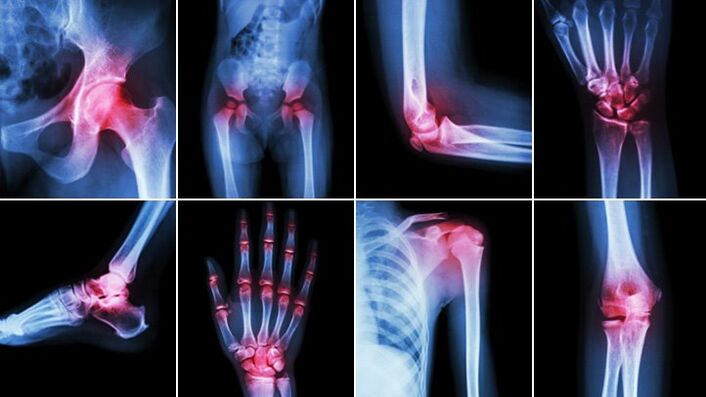
Cause of disease
The disease can develop without a cause (idiopathic or primary). Pathological processes in the body often cause a secondary form of pathology. The reasons for the development of joint disease:
- trauma (dislocation, bruise, fracture, ligament tear, meniscus damage);
- birth defects in the development of joints (dysplasia);
- metabolic disease;
- autoimmune diseases (rheumatoid arthritis, systemic lupus erythematosus);
- inflammatory processes (acute purulent arthritis);
- infectious diseases (tuberculosis, encephalitis, gonorrhea, syphilis);
- pathology of the endocrine system (thyroid disease);
- hemophilia;
- age-related changes in the body;
- frequent hypothermia.
Diagnose
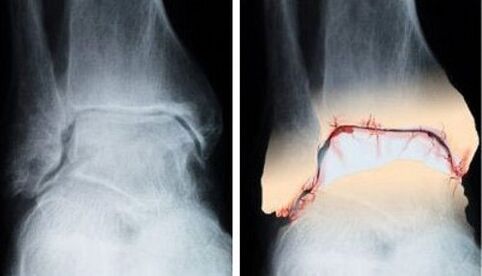
There are several diagnostic methods:
- X-ray exam;
- arthroscopy (examination with a video camera inserted through an incision of 4-5 mm);
- blood analysis;
- Histological examination of the synovial capsule (joints, non-renewable connective cells, appearance of atrophic villi, decreased number of vessels).
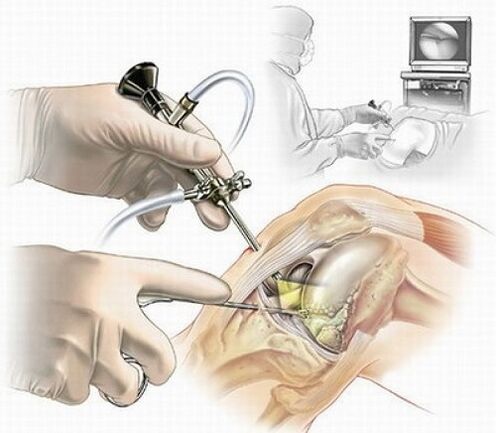
Degree of joint damage
A classification is used, consisting of 4 stages of disease development.
Early stage (disease does not affect the ability to work):
- mild limitation of joint movement in only one direction;
- no bone growth on x-ray;
- uneven cartilage surface;
- the narrowing of the joint space begins.
Second stage (affecting ability to work):
- moderate mobility restriction;
- a strong crunching sound when changing the position of the limb;
- partial atrophy of adjacent muscles;
- bone growth, bone-forming substance;
- lumen of clearance is 2-3 times less than rated.
Third stage (disability):
- joint deformity;
- restricted movement;
- pain with movement and at rest (analgesia with analgesics);
- no common spaces;
- muscle atrophy;
- chemistry of the joint surface.
Fourth stage:
- severe pain that does not go away after taking painkillers.
- completely destroy the joint.
Basic treatment
Arthritis therapy includes several approaches. To achieve a positive result, it is necessary to take the drug, monitor the weight. Physiotherapy, therapeutic movements are prescribed. In severe cases, surgical treatment is performed.
Medical
The main task in the treatment of joint diseases is to eliminate pain. For this, drugs of different groups are prescribed:
- Non-steroidal drugs in the form of tablets, suppositories, ointments, gels, injections. Long-term use of these drugs adversely affects cartilage tissue.
- Corticosteroids. They are used in severe cases to relieve pain, not slow the progression of the disease. With uncontrolled use, cartilage thins out.
- Pain reliever, antispasmodic. Poorly reduced inflammation, but effective for pain relief.
- Chondroprotectors. These are the main drugs for the treatment of joint diseases, they provide nutrients to cartilage tissues, stimulate cell regeneration. They do not work quickly, the condition of bones and joints is gradually improved. Effective even at stage 3 of the disease.
- Vasodilators. Necessary to improve blood circulation, eliminate spasm of small vessels. Improves the activity of chondroprotectors.
Physical therapy

With dry joints, physiotherapy is effectively used. The procedure includes warming up the joints. Dry heat slows down the destruction of bone and cartilage tissue, relieves pain, and improves the patient's general condition.
The following methods are used to treat the disease:
- ultrasonic effect. High-frequency sounds act on the body's tissues, causing a number of beneficial effects. With micro-massage, muscles are warmed, blood flow in the capillaries is improved, and metabolism is accelerated.
- Electrophoresis. Under the action of a low-voltage electric current, the drug is injected into the problem area without affecting other parts of the body.
- magnetic therapy. The application of the method helps to reduce inflammatory reactions, strengthen blood vessels, improve blood flow and speed up cell regeneration in the problem area.
- Exposure to radiation (using infrared, ultraviolet, or laser radiation). It is used as an adjunct to other physical therapy methods or when their use is contraindicated.
Surgery
In the absence of positive dynamics in the treatment of rheumatic diseases, surgical methods are used:
- Intervention activities. There are four types: joint preservation, joint replacement, joint resection, and joint enhancement. The choice depends on the degree of development of the disease, on the intensity of the pain, on the individual characteristics of the patient.
- Puncture. It is done with advanced joint disease. It performs 2 functions: relieves pain in damaged joints and relieves tension inside the capsule, removing substances that in turn destroy cartilage tissue. It is an informative diagnostic method. In this procedure, after a local anesthetic, medication is injected into the joint.
- Arthroscopy. Usually performed on an outpatient basis. During surgery, pieces of cartilage or bone can be removed from the joint, meniscus can be treated, reconstructed ligamentous apparatus, and cleaned of joint surfaces deformed during degeneration. articulation. It is performed under general or local anesthesia.
- Joint anatomy. Arthroscopy is performed if arthroscopy is not positive. Indicated when the joints are swollen for a long time and the pain is severe continuously without taking the drug. It is recommended if you want to remove large pieces of cartilage or bone tissue.
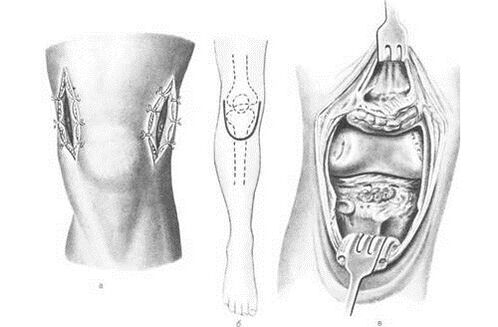
The manipulations to change the position of the joints are performed in cases where it is necessary to reposition the bones, there are defects in the structure of the joints, to prevent joint diseases.
exercise therapy
Physical therapy exercises can help in the early stages of the disease, when the joint is not yet deformed. Active movement slows the course of the disease, but with joint damage, when the disease has progressed to a later stage, physical exercises can contribute to the development of an exacerbation and destruction of tissues in the area. problem.
You only need to do it after consulting with a therapist, who will help you choose a set of exercises and master the method of implementation. The first training should take place under the supervision of an instructor.
When performing exercises, you must follow the rules:
- Avoid stress on the injured joint.
- Moderate exercise speed does not cause damage to the joints.
- Rest and exercise must be balanced.
- Heavy loads and high intensity of movement increase pain and cause joint swelling.
- In any position on the body, it is important to remember the correct posture.
Regular exercises of exercise therapy help to increase range of motion, relax muscles and improve the patient's general condition.
Manual therapy
Combined with drugs in the treatment of joint diseases, manual therapies are applied to increase the mobility of damaged joints, prevent muscle atrophy, and have a positive impact on the whole body of the patient.
During the session, the following operations are performed:
- Relax (complete relaxation) of the muscles involved in the functioning of the diseased joint.
- Perform low-frequency maneuvering of the joint surface to extend the joint's range of motion to the limit of joint mobility.
- Acupressure according to the Schwartz method to bring the muscles to a resting state.
- The use of laser therapy and equipment.
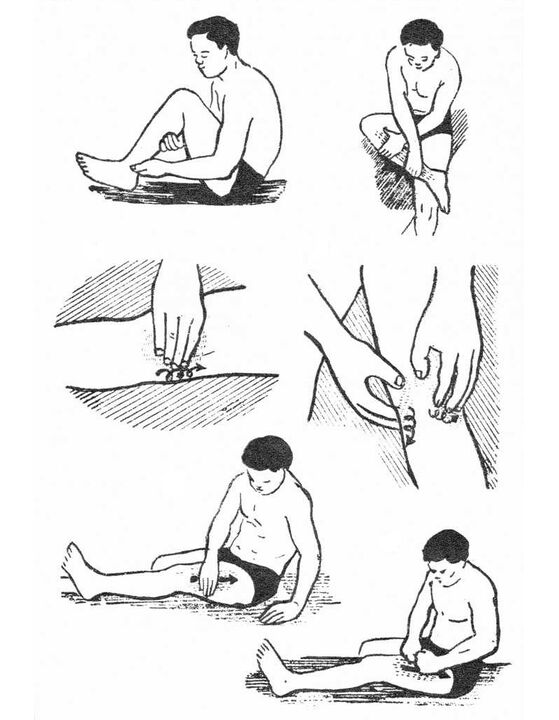
Ethnographic
Folk remedies are actively used in the treatment of joint diseases to activate the production of collagen - the basis of tendons and cartilage. They also reduce joint swelling and pain. Recipes include plants such as thyme, cinquefoil, dandelion (root), strawberry and birch leaves, and willow bark.
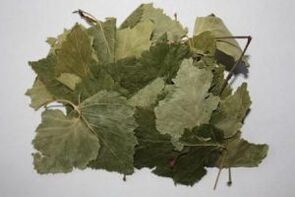
There is a simple but effective way is to use the doggie leaves. To do this, you need to choose comfortable clothing that fits the area affected by arthritis (high socks or ankle socks, tight socks to treat the knees, and tight socks for those affected by arthritis). hip joint). At night, you need to apply the leaves to the diseased joint and wear suitable clothes. You cannot cover the fabric with polyethylene.
The leaves will absorb all salt, toxins and cholesterol deposits from the diseased joint, the skin after the procedure will become smooth as velvet. The course of treatment is 6-7 courses, before use, a doctor's consultation is necessary, because. There may be contraindications to use.
In folk medicine, ointments, infusions, freshly pressed juices, compresses used to combat joint diseases are often recommended by doctors in combination with drugs. The effect of all non-traditional remedies is to relieve pain and swelling of damaged joints, restore tissue and improve the patient's general condition.
But you can not engage in self-medication, otherwise complications may arise.
Is it necessary to readjust your diet?
With joint disease, it is necessary to adjust the diet, which is needed to improve metabolism, reduce body weight if necessary, strengthen connective tissues and cartilage and ligaments. There is no special diet. To achieve a good result in treatment, the following rules must be observed:
- Taking into account the calorie content of the meal so that in normal weight patients it remains stable and in overweight patients it returns to normal.
- Fatty, smoked, semi-finished dishes containing flavor enhancers, dyes and preservatives are prohibited.
- Products should be natural: low-fat fish and meats, seafood rich in minerals and vitamins, fresh fruits and vegetables, hard cheeses, butter, low-fat cheeses, nuts, eggs, ryeand bran bread, high quality vegetable oil rich in unsaturated fatty acids.
- It is necessary to limit the daily salt intake to 8 g.
- Drink at least 2-2. 5 liters of water per day.
- Include in the diet foods that include natural protective chondroprotectors: lean chicken, cartilage, red fish, hard cheeses. Increased use of gelatin, which normalizes the structure of cartilage tissue, strengthens it. To do this, you need to include in the menu a variety of jellies, jellies, aspic fish, kissing fish.
- It is necessary to spend 2-3 days unloading per week (cheese, kefir, fruit and vegetable days).
What is the danger of the different stages of the disease?
In the early stages of the disease, arthropathy is manifested by periodic attacks of pain in the joints and partial limitation of mobility. The danger of the disease is that if you ignore its first symptoms, then in the subsequent stages of development, the pathology leads to the destruction of joint tissues. Consequences - complete loss of mobility. Patients are classified as disabled according to the stage of disease development and the condition of the joints.
Prevent
Prevention of joint disease is as follows:
- Control body weight.
- Properly balanced nutrition.
- Moderate physical activity.
- Avoid hypothermia of the joints.
- Wear comfortable shoes.
- Healthy lifestyle.
Inference
The danger of the disease is that the patient can completely lose the ability to move. Knowing the symptoms of the disease, the causes of its development and methods of struggle, you can get rid of the pathology in the early stages.



























